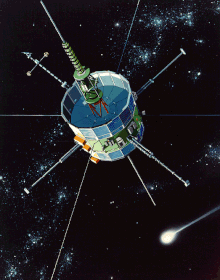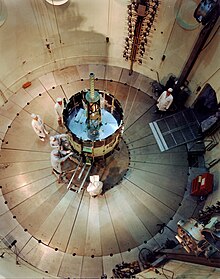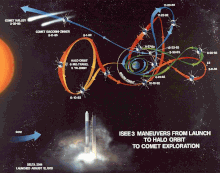ISEE-3 / ICE
ISEE-3 ( I nternational S un E arth E xplorer- 3 , later renamed ICE ( I nternational C ometary E xplorer )) is an American space probe that was used between 1978 and 1997 to explore the earth , the sun and comets was active and who made the first approach to a comet in 1985. She took measurements but did not take any pictures.
ISEE program
In 1977, NASA and ESA launched three satellites under the name “ International Sun-Earth Explorer ” (ISEE, in English: International Sun and Earth Explorer ) . The first two went into orbit together as early as 1977 . The aim was to research the earth's magnetic field.
Primary mission
The highlight of the ISEE program, however, was the space probe ISEE-3 (also "ISEE-C" and "Explorer 59"; US American with European participation). On August 12, 1978, this probe was brought into a Halo orbit around the Lagrange point (also known as the libration point) L 1 , 1.5 million km from Earth, using a Delta 2914 rocket . From here ISEE-3 was supposed to investigate the interaction of the earth's magnetic field with the sun.
Extended missions
When the visit to Halley's Comet was imminent in 1986, NASA and ESA had initially decided on a joint mission. Each of the two space agencies should send a probe. However, due to budget cuts, the NASA probe was canceled in 1981 (the European probe was Giotto ). In order not to have to leave the field to the Europeans, Russia and Japan when exploring the comet, NASA looked for an inexpensive replacement. ISEE-3 was a probe that had suitable equipment on board. The probe was withdrawn from its halo orbit around L 1 and steered past the earth and moon in a number of complex “gravity assist” maneuvers ( swing-by ) . After that, the probe had sufficient speed to leave the earth's gravity field. The 480 kg probe was then given a new name: "International Cometary Explorer" (ICE; in German: International Cometary Explorer).
On the way to 1P / Halley, she flew through the tail of the comet Giacobini-Zinner on September 11, 1985 .
ISEE-3 later provided supporting measurements for the Ulysses solar probe .
course
- ISEE-3 launched on August 12, 1978.
- The probe reached orbit around the L 1 point on November 20, 1978 .
- On June 10, 1982, ISEE-3 began maneuvers that resulted in exiting the L 1 orbit on September 1, 1982.
- The first "gravity-assist" maneuver on the moon took place on October 16, 1982, further on March 30, April 23, September 27 and December 22, 1983, after which ISEE-3 left the earth's gravity field. Twice, on February 8 and June 30, 1983, the probe had also passed the L 2 point (facing away from the sun) .
- On September 11, 1985, the probe now known as ICE flew past the comet Giacobini-Zinner at a distance of 7,800 km .
- In contrast, ICE made only a small contribution to the observation of Halley's Comet . The probe was 31 million km from the comet in March 1986 , so little useful knowledge could be gained.
- In the 1990s, ICE supported the European-American solar probe Ulysses.
- On May 5, 1997, the probe was abandoned.
Results
ISEE-3 / ICE was a pioneer in many ways: It was the first US probe with European participation - later standard. It was the first probe in an orbit around L 1 and also the first in the vicinity of L 2 - standard positions for probes from the 1990s. And it was the first probe to pass a comet. This flyby confirmed u. a. that comets mainly consist of water ice, but also of gases, organic molecules and dust.
Return in 2014
When ISEE-3 / ICE returned to earth in 2014, the Deep Space Network was aligned with the satellite's position in September 2008 and it was found that the probe is still operating and transmitting telemetry data . Their evaluation showed that 12 of the 13 instruments are still in function and there is still enough fuel on board to reach a new destination. However, NASA is no longer able to send signals to the probe, as the transmitters required for this in the Deep Space Network were dismantled in 1999 and rebuilding would be too expensive. On March 1 and 2, 2014 radio amateurs managed to receive the beacon transmitter of the probe at the Bochum observatory . Considerations were made to set up a transmitter there for communication with the probe in order to be able to send it onto a trajectory suitable for further scientific experiments.
Other projects, based on the Lunar Orbiter Image Recovery Project (LOIRP) , are also trying to establish contact with the probe using historical data. On May 29, 2014, the Space College announced that two-way communication could be established via the Arecibo Observatory . The Space College plans to put them into orbit for further use there.
On July 2, 2014 - after the probe's last maneuver on February 2, 1987 - it was possible to reactivate the engines and correct the rotation from 19.16 to 19.76 revolutions per minute, which is now within the tolerance threshold of the original mission parameters (19.75 ± 0.02). On the other hand, the first attempts to correct the course failed because of problems with the engines, as the nitrogen gas that is pushing the fuel out of the tanks has probably run out.
Since then, ISEE-3 has been in orbit around the Sun and will not be near Earth again until August 2029. Some of the experiments on board could be activated and transmitted measurement data. On September 16, 2014 radio contact with ISEE-3 was lost. It is assumed that the probe has switched to safe mode due to insufficient power supply. The reason for the collapse of the power supply is the increased distance to the sun, as the probe does not move at an even distance from the sun.
Structure of the probe
More detailed description: → ISEE / ICE program # ISEE 3
ISEE has a cylindrical main body with the engine or the main antenna on each end. Four long measuring antennas with a span of 91 meters each protrude to the side . The total mass of the probe is 390 kg. There are thirteen scientific instruments on board.
Popular culture
- In the xkcd comic of March 3, 2014 reference was made to ICE.
- Various media reported in 2014 that the visit to Comet Giacobini-Zinner was initiated by one of the mission designers from ISEE-3.
See also
Web links
- Nasa / HEASARC Mission Overview (English)
- Bernd Leitenberger: International Comet Explorer (ICE)
- Space College Documentation on Attempts to Reactivate the Probe
- Home Photo by ISEE-3 at Space College (English)
Individual evidence
- ↑ International Sun-Earth Explorer (ISEE) (English)
- ↑ International Sun-Earth Explorer 3 - International Cometary Explorer ( Memento from July 12, 2014 in the Internet Archive ) (English)
- ↑ ICE / ISEE-3 to return to an Earth no longer capable of speaking to it (English)
- ↑ Manfred Holland (mho): ISEE-3 / ICE: Researchers contact ancient probe. Heise online , June 6, 2014, accessed on July 22, 2014 .
- ↑ AMSAT-DL and Bochum Observatory receive signal from retired NASA spacecraft. (No longer available online.) Archived from the original on March 30, 2014 ; accessed on March 30, 2014 . Info: The archive link was inserted automatically and has not yet been checked. Please check the original and archive link according to the instructions and then remove this notice.
- ↑ We're Looking for Original ISEE-3 Telemetry Tapes. Retrieved April 17, 2014 .
- ^ We Are Now In Command of the ISEE-3 Spacecraft. Retrieved May 30, 2014 .
- ↑ Roman van Genabith: Is the ICE returning to earth to stay? , in raumfahrer.net, Date: June 13, 2014, Accessed: June 16, 2014
- ↑ Urs Mansmann (uma): ISEE-3 / ICE: The engines of the once lost probe ignited. Heise online , July 3, 2014, accessed on July 3, 2014 .
- ↑ Keith Cowing: ISEE-3 Engines Successfully Fired For spin-up. Space College, July 2, 2014, accessed July 3, 2014 .
- ↑ Roman van Genabith: ISEE 3 ignites engines. Raumfahrer.net, July 5, 2014, accessed July 9, 2014 .
- ↑ Urs Mansmann (uma): ISEE-3 / ICE: Course correction of the ancient probe failed at the first attempt. Heise online , July 9, 2014, accessed on July 9, 2014 .
- ↑ Urs Mansmann (uma): ISEE-3 / ICE: The ancient probe's engines no longer ignite. Heise online , July 10, 2014, accessed on July 16, 2014 .
- ↑ http://www.spektrum.de/news/wiederbelebung-der-toten-raumsonde-isee-3-gescheitert/1300466 Spectrum of Science - Resuscitation of the "dead" space probe ISEE-3 failed?
- ↑ Keith Cowing: ISEE-3 post Lunar Flyby status and Modification of Mission Goals. Space College , August 28, 2014, accessed April 25, 2015 .
- ↑ Keith Cowing: ISEE-3 is in Safe Mode. Space College , September 25, 2014, accessed April 25, 2015 .
- ↑ http://spacecollege.org/isee3/what-isee-3-really-looks-like.html
- ↑ ISSE 3 in the NSSDCA Master Catalog (English)
- ↑ xkcd comic: Hack (English)
- ^ The hijacking of ISEE-3 ( memento from April 1, 2014 in the Internet Archive ) Tagesschau from March 29, 2014
- ↑ Space Thief or Hero? Article on National Public Radio website




